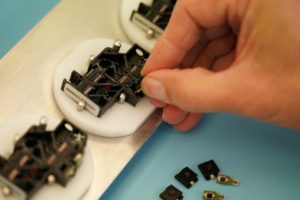Light reflection and fluorescence are the two phenomena we usually focus on when developing our detectors, but once in a while we receive new and exciting challenges, which allow us to push our design a step further. In this case, it was photon upconversion. The working principle of the “usual” detector is simple: Detected light has the same or lower energy than the emitted light, so we design our optics accordingly. However, knowing that what we created was flexible enough to include more principles, we partnered with Leiden University in the Netherlands to create a detector that works in a reverse order without having to compromise on its small form factor or performance. Using an infrared laser and custom optic beam-splitters and filters, we managed to create the upconverting phosphor (UCP) detector. This little but powerful device could emit IR laser with an intensity that is adjustable via software, and read up to two wavelengths under 800 nm. The detected light being of shorter wavelength than IR’s. The genius part is that all emitted and received light beams go through the same channels, thus giving us and our customers what they needed in a very compact and efficient package. 
